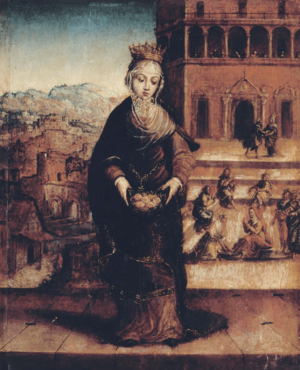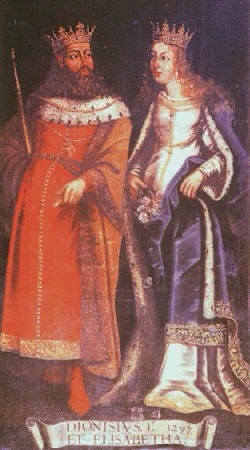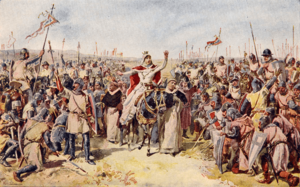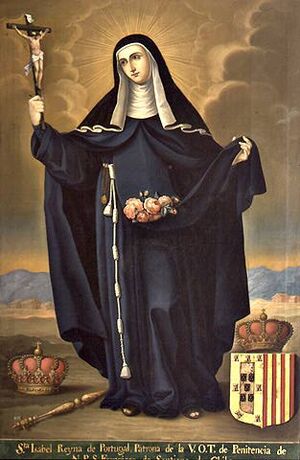Elizabeth of Portugal facts for kids
Quick facts for kids Elizabeth of Portugal |
|
|---|---|

Queen Santa Isabel and the Miracle of the Roses; c. 1540
|
|
| Queen consort of Portugal | |
| Tenure | 26 June 1282 – 7 January 1325 |
| Born | 4 January 1271 Aljafería Palace, Zaragoza, Kingdom of Aragon |
| Died | 4 July 1336 (aged 64–65) Estremoz Castle in Estremoz, Alentejo, Kingdom of Portugal |
| Spouse | Denis, King of Portugal |
| Issue | Constança, Queen of Castile Afonso IV, King of Portugal |
| House | House of Barcelona |
| Father | Peter III, King of Aragon |
| Mother | Constance of Sicily |
| Religion | Catholicism |
Elizabeth of Aragon (born in 1271, died in 1336) is better known as Elizabeth of Portugal. She was a queen of Portugal and is considered a saint in the Roman Catholic Church. She was also part of the Franciscan Order, a religious group.
Contents
Early Life and Family

Elizabeth was born in 1271 into the royal family of Aragon. Her father was Peter III, who later became king. Her mother was Constance of Sicily.
Elizabeth had three brothers who also became kings: Alfonso II, James II of Aragon, and Frederick III of Sicily. She was also the great-niece of Elizabeth of Hungary, another famous saint.
From a young age, Elizabeth was very religious. She prayed daily, fasted often, and performed other acts of penance.
Marriage to King Denis
Elizabeth's marriage to King Denis of Portugal was arranged in 1281 when she was only 10 years old. As part of her dowry (money or property brought by a bride to her husband), she received the towns of Óbidos, Abrantes, and Porto de Mós.
The wedding ceremony took place in 1288, when Elizabeth was 17 and Denis was 26. King Denis was known as the Rei Lavrador, which means "Farmer King." He earned this name because he planted a large pine forest near Leiria. This forest helped stop the land from eroding.
Elizabeth continued her religious practices and helped those in need. She was very dedicated to the poor and sick.
A Peacemaker Queen
Elizabeth was actively involved in Portuguese politics. She played a key role in making peace during important negotiations. For example, she helped with the Treaty of Alcañices in 1297. This treaty set the borders between Portugal and Castile.
In 1304, Elizabeth and King Denis traveled to Spain. They helped settle a disagreement between Fernando IV of Castile and Elizabeth's brother, James II of Aragon.
Elizabeth had two children: a daughter named Constance and a son named Afonso. Constance later married King Ferdinand IV of Castile. Afonso became King Afonso IV of Portugal.
Elizabeth often acted as a mediator between her husband and their son, Afonso. A civil war almost broke out between them from 1322 to 1324. Afonso was angry because he believed his father favored his illegitimate son, Afonso Sanches.
In 1323, Elizabeth bravely rode her mule between the two armies. She stopped them from fighting. Peace was made in 1324. The illegitimate son was sent away, and Afonso promised loyalty to his father.
Later Life and Legacy
After King Denis died in 1325, Elizabeth moved to the Monastery of Santa Clara-a-Velha in Coimbra. She had founded this monastery in 1314. She joined the Third Order of St. Francis, dedicating her life to helping the poor and sick.
During a great famine in 1293, she gave flour from her own storage to people starving in Coimbra. She was known for dressing simply and speaking humbly. She also provided lodging for travelers, gave small gifts, paid for poor girls' dowries, and educated children of poor nobles. She supported many hospitals and religious projects.
In 1336, Elizabeth was called to be a peacemaker one last time. Her son, King Afonso IV, was marching his troops against King Alfonso XI of Castile. Alfonso XI had mistreated Afonso's daughter, Maria.
Despite her age and weakness, Elizabeth rushed to Estremoz, where the armies were gathered. She again stopped the fighting and helped arrange a peace agreement. This great effort caused her to fall ill. She died on July 4, 1336, in Estremoz Castle. Because of her efforts to solve disputes, she earned the title of Peacemaker.
Elizabeth was buried in a beautiful Gothic tomb in the Convent of Santa Clara in Coimbra. Due to frequent flooding, her remains were later moved to the Monastery of Santa Clara-a-Nova. Her body was placed in a sarcophagus made of silver and crystal.
Sainthood
Elizabeth was declared "blessed" (beatified) in 1516. She was made a saint (canonized) by Pope Urban VIII on June 24, 1626. Her feast day, a special day to remember her, is celebrated on July 4.
In the United States, her feast day is sometimes moved to July 5. This is because July 4 is a national holiday for Independence Day.
Elizabeth is often shown in royal clothes. She might also be seen with a dove or an olive branch, symbols of peace.
Images for kids
-
King Denis of Portugal and Queen Elizabeth of Portugal
See also
 In Spanish: Isabel de Portugal (santa) para niños
In Spanish: Isabel de Portugal (santa) para niños







